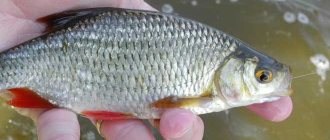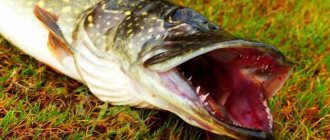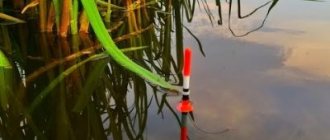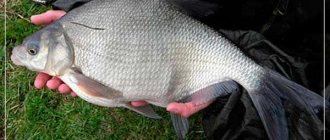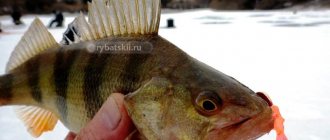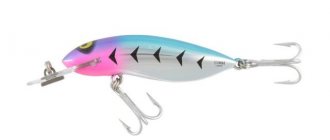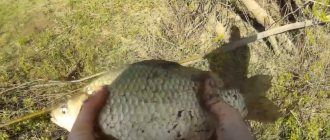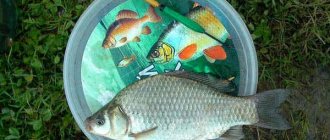The Russian winter lasts a long time. Fans of open water fishing, tired of their favorite pastime, first of all in their dreams of summer imagine a float gently swaying on the surface of the water. In some ways, this is an echo from childhood, in which each of us used to begin our acquaintance with our favorite pastime by mastering a float rod.
And, you see, the first catch in open water is not at all important, what is important is the fishing itself in the spring with a float, which charges us with adrenaline for the whole season. Today we’ll talk about how to achieve unity with nature and make your first trip to the pond unforgettable.
Fishing place
Most fish spawn in shallow waters, laying eggs on underwater objects:
- small snags;
- remnants of last year's vegetation;
- stones;
- man-made objects.
This is where fishing should be done.
In grassy thickets flooded with water, the fish feel safe and actively bite.
In the very early spring, when the water has not yet arrived, it is worth examining the places where the tributaries flow into the reservoir:
- small rivers;
- streams;
- ravines;
- powerful streams of melt water.
In a large body of water, fish are drawn to such locations due to the abundance of oxygen dissolved in the supplied water, as well as in the hope of ingesting food items washed out of the soil by streams.
Features of spring fishing
The beginning of spring fishing with a float rod occurs during the freeze-up period, when the water in reservoirs is freed from the ice load and begins to be cleared of various types of impurities. It is known that river inhabitants become more active in warm water, so you should go to reservoirs when the sun warms them up properly. Since the water in small reservoirs warms up faster, it is more advisable to fish them first in early spring, and only then go to larger reservoirs.
The bite at the beginning of spring is unstable, as is the spring weather itself. Its effectiveness is affected by the direction and strength of the wind, fluctuations in the atmospheric background, weather conditions and many other factors.
Read: Advice for parents of young anglers
It is more difficult for fishermen who fish in uncharted waters, because they need to find “catching” places by reconnaissance of the area.
In early spring, the water level in reservoirs is still high: not all the snow has melted, and it rains heavily. This makes the fishing process very difficult. To avoid undesirable consequences, experienced fishermen recommend positioning themselves in areas of reservoirs near high, steep banks. In such places, the water overflows its banks less often, and therefore fishing will be more comfortable. Having a boat greatly simplifies the fishing process.
Advice: be sure to read the rules of the local fishing society; the use of watercraft may be prohibited at this time, so you will have to fish from the shore.
Tackle
If the conditions of the reservoir allow, you can use any float, but still the main fishing rod of this season is the swing. It is the fly tackle that is most mobile, allowing you to fish both among snags and in thickets of grass.
Attention! With fly tackle it is easiest to find the required fishing horizon in which the fish is located at a particular moment.
The spring fly rod is chosen depending on the fishing conditions. For coastal fishing, it can be up to eight meters long. Wading fishing involves using a lighter fishing rod, the optimal size is 3-4 meters.
Equipment
Often a flooded reservoir does not allow you to get closer to the fish’s resting place, so you have to go into the water. To do this, use wading boots or waders - waders. This allows you to fish in flooded meadows.
Overflowing rivers flood the meadows, and various fish come here to spawn. For fishing here you will need wading boots.
The second option for fishing in such places is to use boats. The vessel is placed close to the border of aquatic vegetation, and the casting of the float rod is made under the very edge of the grass.
Equipment
Fishing in spring is also distinguished by the elegance of the gear. Underwater inhabitants are still very cautious and distrustful of any rough installation. Therefore, the fly fishing rod is equipped with a fishing line of 0.10-0.12 millimeters without a leash. In another option, you can use a base of 0.12-0.14 millimeters and set a bend of 0.08-0.10.
As a rule, thicker fishing lines are used on a river than in reservoirs without a current.
Advice! The exception is carp fishing and fishing with a predator float. There, the equipment chosen is powerful - to match the likely trophy.
In the pre-spawning period, when the fish has a pronounced hunger, the equipment can be slightly strengthened. However, you still shouldn’t get carried away with thick fishing lines; the bite is noticeably better with delicate tackle.
The float on the fishing rod is also light, a maximum of two grams for still water and four for current. The load is mounted according to its weight. In this case, it is worth observing the rule of several pellets.
The presence of several pellets allows you to quickly reconfigure the tackle by moving them along the fishing line.
Where to catch crucian carp in the spring on a float
The beginning of the spring bite can vary greatly in different regions. But the main criterion for the opening of the season can be considered the melting of ice and an increase in temperature to + 10 +12 °C. With the advent of warming, crucian carp are activated and come out from the depths closer to the sun-heated shallows.
You should start searching for fish from areas overgrown with last year’s grass. Promising places in early spring are considered to be exits from edges, small creeks or snags. An important condition is a depth of up to 2-2.5 meters, stable warm weather.
On rivers and rivulets, it is better to look for crucian carp along the coastline, closer to the vegetation. Pools, whirlpools, eddies and areas with weak currents are suitable. A good place for catching crucian carp on a float will be small lowlands flooded with floods, densely overgrown with last year’s grass. The depth of such spills should not exceed 1-2 meters. The water in these areas is quite warm and rich in food.
Towards the beginning of May, crucian carp begin to prepare for spawning and more often swim into open areas and small shallows in search of food. The pre-spawning period is a great time to catch fairly large specimens. After spawning, females are sick for about 2–3 weeks. During such a period, the bite of crucian carp practically stops and you can only count on catching small specimens that have not yet reached the stage of spawning.
Read more about when crucian carp start biting in the spring.
The effectiveness of fishing with a float also depends on the time of day. Crucian carp bite well in the morning and evening hours. During the day, biting activity decreases, as the fish prefers to bask in the sun, slowly digesting a hearty breakfast. There is practically no fishing at night, since sharp drops in temperature in the dark act on the silver glutton like autumn cold snaps.
The secret to catching crucian carp in the spring with a float rod is to constantly move behind schools of fish. This is due to the fact that areas of water warm up unevenly, and crucian carp constantly moves throughout the entire reservoir in search of warmth and food.
Lure
Spring bait should not saturate the fish, it should collect it at the selected point. Therefore, the mixture should consist of 50 percent inert components - soils. You don’t have to buy them at a fishing store; you can dig them up on the shore and sift them yourself using a metal sieve.
Advice! Soil from a garden store will also work. Moreover, you can choose a different composition for buoyancy: light peat or heavy humus.
It is also necessary to include a loosening component that produces turbidity in spring bait. It can be:
- ground crackers;
- semolina;
- powdered milk;
- bran;
- coconut flakes.
Features of catching spring roach in currents and still water
River roach is no different from those found in stagnant bodies of water, and the habits of the fish are almost the same. But catching sorog in the spring with a float rod has its own characteristics and depends on the type of reservoir.
On the current
When fishing in a current, you have to use heavy floats and weights to make it easier to cast to a distant point. During the current, recasts are made with a certain frequency, because when the float is delayed by the rod, the bite is difficult to see. The fisherman chooses a rhythm and fishing distance that is convenient for him, and the tackle reacts to the slightest touch of the fish.
In spring, it is preferable to use animal baits on the river, and an animal component is also added to the bait. Thin hooks with a long shank and a short sting are best suited for attaching maggots or bloodworms. To weight the bait mixture, clay from a reservoir is used, or dry weighting agents sold in stores.
After preliminary feeding with 5–10 balls, the fish are fed 1–2 balls every half hour. You can’t feed the roach generously in the spring; this will reduce the intensity of the bites, as the fish quickly become saturated. When the bite is inactive, the leash is lengthened and the thinnest leash lines are installed. After casting, the hook with the nozzle slowly sinks to the bottom and is pulled by the current parallel to the bottom.
The bait behaves more naturally and the fish is not afraid to come up and taste it. Minimal movement and sinking of the float indicates that the roach is interested in the bait and you need to hook it immediately.
Important! Changing the position of the nozzle on the hook helps to activate the roach's bite during the current. The maggot or bloodworm is placed on the sting not with a stocking, as usual, but across it, and in this position the nozzle may interest the fish.
On still water
Catching roach in spring in still water is more difficult, because the fish are cautious and the correct presentation of the bait comes to the fore. A very long leash will not help here, because the bait will fall to the bottom and you will have to twitch the tip of the rod to set it in motion.
Instead of a shed, a small swivel is used, which, among other things, also prevents the equipment from spinning and getting tangled. The maximum leash length is up to half a meter, hooks number 16–18.
Floats should be small with thin, oblong-shaped antennas, with a long metal keel. This will help increase the sensitivity of the gear and improve the visibility of bites.
Some anglers, when fishing on a lake, place not one, but two leashes on the yoke, in the hope of increasing the chances of a good catch.
Such a step is unjustified, because the tackle becomes coarser, it alarms the fish and it will bite worse. By the end of April - beginning of May, the use of plant baits with small hooks with a short shank is justified. When fishing with dough, hooks with springs are used to help keep the bait on the hook for a long time.
Bread crumb with ground flour is one of the best options for May baits for roaches and it is better to store it in a jar with a closed lid so that the bait does not become weathered and the attractive aroma does not evaporate.
Another catchy bait that roaches bite on in early spring on a float rod in still water is steamed pearl barley. The fisherman places one boiled grain on the hook, and the large roach willingly bites both in the water column and closer to the surface.
To prepare such an attachment, just steam a couple of handfuls of pearl barley in a thermos in the evening and by morning, it will be completely ready for use. In this case, there is no need to use any additional flavorings; fish like the natural smell of boiled barley grains.
When attaching pearl barley or other baits, leave the hook tip open, this will improve the quality and reliability of the hook.
Important! When fishing in still water, you should not leave the tackle in the water for more than 10–15 minutes, because during this time the bait will soften and fall off the hook, or the fish will pull it off.
Lures
Features of fishing on the feeder in April
In addition to bloodworms, which are common for fish in winter, other baits are also actively used in spring;
- maggot;
- worm;
- semolina mash.
The good thing about semolina in spring is that it is very easy to flavor; spices are used for this:
- garlic;
- anise;
- dill.
It should be noted that you should start fishing without an attractant, using semolina in its natural form. Often the own smell of fish grain is quite attractive in itself.
It is convenient to insert semolina through a disposable plastic syringe.
Catching certain types of fish
Bream
Fishing for bream in the spring with a float rod is most favorable on sunny days. Moreover, it has been noted that in standing reservoirs it is much easier to find or collect fish for bait than on a river. The fact is that spring meltwater can significantly change the topography of the river bed, which leads to a change in parking areas.
In any case, on the river you need to examine locations on the border of currents, places with pronounced backflows, entrances and exits from bays.
It is best to look for spring bream in shallow bays, where they come in anticipation of spawning. If there are few such places in the reservoir, depths of 1.5-2 meters should be examined.
Attention! Together with the bream, its usual companions are often caught: sopa, silver bream, blue bream. In the upper water horizon, a bite of sabrefish may occur.
The bream are fed with small balls, the consistency of which allows them not to crumble when moving to the bottom.
Roach
You need to look for roach in the spring near the shores, where they come to bask in the sun and profit from what the melt waters brought into the reservoir. And in general, the sorog will most often be found in the warmest places. Experienced fishermen even take a thermometer with them when fishing, which they lower into the water and attach to the equipment.
It is advisable to feed roaches in the spring with dusty components. One of the best options would be a mixture of ground crackers and small bait bloodworms.
In the spring you can hope for solid specimens of roach.
In the upper fishing horizon, rudd or bleak can be caught along with roach.
crucian carp
This popular fishing object behaves in the spring in a similar way to other cyprinids. It rises from the depths to the shores, looking for warm areas heated by the sun. It often happens that the crucian bite begins 2-3 hours after sunrise.
Closer to spawning, crucian carp become even more picky. On the one hand, it can peck at any bait, on the other hand, it is difficult to gather it with bait to a certain place. The fish loiters along the shoreline, literally approaching the angler’s feet.
Taking into account the above, we recommend catching crucian carp in the spring with 2-3 fishing rods, which need to be cast at close but different distances from the shore.
Of the baits, semolina with garlic or maggot is preferable.
Perch
Catching perch in the spring with a float rod is also possible. Small sailors will peck well on a dung or earthworm, a leech or a snail. Large fish can be tempted with live bait in the form of a top-water bait or a small bleak.
The worm must be planted in a bunch. Even the mouth of a large perch will be happy with such a piece.
Perch is a mobile fish, so it is practically not tied to a specific place in the reservoir. Its predatory nature forces it to move to places where small fish accumulate, precisely in places where the fry fatten, and it is worth looking for the striped robber in the spring.
Types, equipment and techniques of fishing with a float rod
The instinct of a hunter (breadwinner) is inherent in every man and even in some women. The process of fishing not only satisfies the natural need of the strong half of humanity - getting food, but is also an excellent vacation. So that your vacation is not overshadowed by the absence or meager catch, let’s figure out which float fishing rod equipment is the most universal - that is, suitable, as they say, for all occasions. In addition, we will reveal the secrets that torment novice fishermen, which rod to choose, how to equip it correctly - install a hook, weight, float. Let’s not ignore the frequently asked question about how to fish with a float rod in reservoirs. Particularly on the river.
Types of rods for float fishing
Rod, equipment (reel, line, float and sinker with a hook) - a float rod or the elements of which it consists. The first step towards an enviable catch is choosing the right rod for float fishing. A variety of trading platforms that sell all kinds of fishing accessories offer the following types of rods for float fishing:
A plug rod is a new type of float rod consisting of several legs. When assembled, the length of the plug fishing rod reaches from 10 to 15 meters, which allows you to deliver the equipment exactly to the intended fishing point using guide rollers. The last leg of such a fishing rod has an insert made of durable but elastic rubber, the purpose of which is to dampen the powerful jerks of trophy fish.
Photo 1. Elbows of a modern plug.
A match rod is a kind of improved version of a Bolognese fishing rod. A fishing rod with a length of 4 to 7 meters must be equipped with a spinning reel, which helps to cast light equipment over a long distance from the shore of a reservoir. In general, it is for this type of fishing, where long-distance casting of equipment is expected, that a rod of this type is purchased.
Photo 2. On the match form there are a lot of rings on a high leg.
The Bolognese rod is a more advanced version of the ordinary fly rod. The rod is equipped with rings and a reel, which makes it possible to cast the tackle to the required distance. The special floats used in the rig make it a real Bolognese rig. This fishing rod is successfully used by anglers both for wire fishing and for hunting predators with live bait.
Photo 3. The Bolognese fishing rod has a minimal set of rings.
A fly rod is the simplest (traditional) version of a fishing rod for float fishing, where the fishing line is attached directly to the blank itself. Naturally, the distance over which you can cast the equipment will not exceed twice the length of the rod itself, which is enough for both fishing from the shore and from a boat. However, if you wish, you can always equip this type of fishing rod with rings and a simple reel, which will increase the supply of fishing line necessary for longer casts.
Photo 4. Mach does not need rings at all.
Learn more about the elements of a fly rod for float fishing
So, we have decided on the choice of fishing rod. However, one form, even the highest quality, is not capable of catching fish from a reservoir. The equipment or structure of a fishing rod of this type looks like this:
- Fishing line. As a rule, floaters do not use braid, opting for regular monofilament fishing line. For those taking their first steps in the art of fishing, we recommend colorless monofilament fishing line 0.14 - 0.2 mm.
- Float. An important element in the equipment, responsible for signaling a bite, holding the bait at a given depth, and participating in retrieving and casting. Specific recommendations for choosing a float are impossible, since the fishing conditions are varied. Still, the main characteristics of a good float are stability even in strong winds and waves, visibility in cloudy weather and ripples on the water, reliability (strong and water-repellent). From a technical point of view, the following scheme works: at a depth of 1.5 m, you need to install a float with a carrying capacity of up to 2 g. Depths exceeding the 3-meter mark require floats from 3 to 5 g.
- Leash. This element of the equipment should not be ignored, since the leash helps make the equipment more invisible to the fish. For the leash, the same monofilament line is used, the diameter of which should be a few hundredths of a millimeter less than the working one. The length of this element of fishing equipment is 10 – 30 cm.
- Sinker. It is also an important detail in the float equipment, which controls the stable position of the hook with bait in a given place, making it easier to cast the tackle and sinking the float. Actually, a float fishing rod involves the use of weights in the form of pellets (a body of water without a current) and olives (a river). The correct float rig is several pellets arranged in ascending order from a smaller sinker near the hook to a larger one at the top.
- Hook. This element of equipment should be invisible to the fish (at least unnoticeable), durable, and most importantly, sharp and tenacious. Not only must it effectively pierce the fish's lip, but also hold the trophy when fishing. The size of the hook directly depends on the object being fished and the bait. Hooks No. 3 and 4 according to domestic qualifications are intended for maggots, pearl barley and similar baits. For the worm, hooks from No. 8 to No. 10 are used.
How to properly install float equipment?
Having acquired all the elements of the equipment and the fly rod itself, it is necessary to correctly assemble the parts into a single whole so that at a crucial moment no incident occurs. So, the equipment of a fishing rod for fishing for “peaceful” fish (crucian carp, carp, roach, and so on) occurs according to the following scheme:
- To the connector located at the end of the rod, we tie a piece of fishing line equal to the length of the blank itself.
- We thread the line through the float. In relation to this installation option, we use blind rigging - we fix the float on the fishing line with two cambrics on the lower keel and on the upper part of the rig.
- We load the float with weights (lead pellets). To do this, you need a container of water - a bathtub, a bucket, and so on. Ideally, only the tip of the top of the float should stick out above the water.
- We distribute the pellets along the fishing line - at a distance of 1.5 cm from the loop or swivel (the point of connection with the leash), the smallest sinker (supply) is attached. Next, the remaining pellets are installed at intervals of approximately 10 cm.
- The leash with a hook attached to it is attached to a swivel or loop. When installing the leash to the main line, if there is no swivel, you can use the loop-to-loop method or use any fishing knot.
General recommendations on fishing with a fishing rod and float
Well, the float tackle is ready for use. It's time to put it to the test. However, in order for the result to live up to positive expectations, it is necessary to follow the basic rules of fishing, which look like this:
- Although fish is a stupid creature from a human point of view, it still won’t bite on an empty hook - it is necessary to use animals (in spring and autumn), as well as plant baits.
- You should give a signal to the fish that a table is set for them here (at the intended fishing location) using bait - either homemade or purchased in a store.
- To make bait more effective, you can use flavorings.
Of course, for a successful outcome of the event, you need to find a promising place on the river. Experienced fishing enthusiasts, who will a priori be present at a particular body of water, will help novice fishermen with this. In addition, it is necessary to set the correct depth, and without an echo sounder, this can be difficult for a beginner. However, there are no hopeless situations! The correct depth can be set using the same float tackle. We throw the tackle, setting, for example, the hook immersion level to 0.5 m, moving the float. If the float has taken a position as when loading in a bathtub, it means it is much deeper in this place. We achieve a position where, after the next cast, the float rests on the surface of the water - the sinkers have reached the bottom. We lower the float along the line by 20 cm and start fishing along the bottom.
